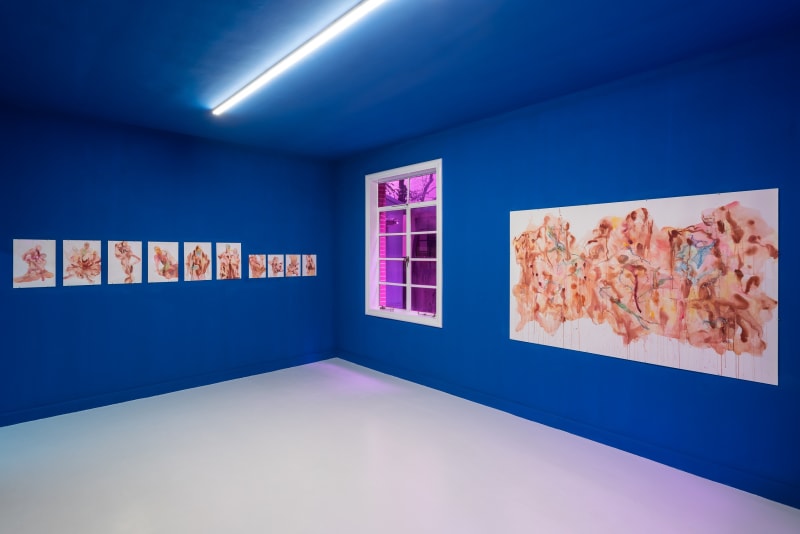At the opening night of Wang Haiyang’s exhibition someone described his work as provocative. The term is standard fare in the art world for things as diverse as “off-putting” to “politically challenging” so saying something is provocative can be a bit of a guessing game. In reference to Wang’s work, I think the person meant “viscerally disturbing,” which is a fine description of the power of the exhibition and one I agree with. The exhibition was aggressively lascivious while simultaneously touching on loneliness and distance—things Wang has repeatedly examined. The distance, the loneliness, and the strange outbursts of lust are symptoms of apathy, and apathy is what I believe Wang wants to end.
This exhibition, specifically the video The City of Dionysus (2018), uses loneliness, lust, and absurdity and brings them to extreme ends. It is one of many videos Wang Haiyang has done in his career but it stands as distinctly graphic (possibly to the point of upsetting some viewers) in comparison to others like Freud, Fish & Butterfly (2009) and Double Fikret (2012), which also address the same concepts. Wang made the earlier videos with a stop-motion camera and pastel drawings on sandpaper that he erased and redrew to unravel a loose narrative based upon his own subconscious associations between images. The earlier pieces are immensely intriguing: you are watching a true Surrealist with a style similar to René Magritte unfold his subconscious like an exquisite corpse. The City of Dionysus, however, is far more refined.
The second half of The City of Dionysus unfolds similarly, but (for the first time) Wang uses watercolors and his subjects—rather than associations of real-world objects—are associations of real-world emotion, specifically lust taken to aggressive extremes. What starts as splashes of watercolor develops quickly into humans in various positions of amorphous passion. Without saying much more, the second half of the video is an intense depiction of the graphic side of lust.
This scene is juxtaposed against the first half of the film, which is a short story about the death and decomposition of a reclusive elderly neighbor whose body went unnoticed for days until, finally, the police broke down the door and discovered her decomposing body. The visuals—timed alongside the narration—start with scenes of construction sites and enormous gasping faces superimposed over debris. The story of the neighbor is embellished by these faces as they cry out for recognition but are ultimately ignored by construction workers tearing down the landscape.
The City of Dionysus leaves us uncomfortable. Perhaps we are unnerved by the truth that lust and loneliness exist simultaneously and can quickly turn us into a nightmarish creature. Or perhaps we are just dismayed by the not-so-subtle images in the video. Or, most frighteningly, we feel nothing.
Just as he brings the relationship between lust and loneliness to the foreground in The City of Dionysus, he contrasts the human and the Other in the expertly-crafted pastel series Skins (2018).
The series is a view of humanoids at a distance established by their hairiness. But all of their actions, desires, and fears are undeniably human. The implication is that we are the ones creating this distance and ennui by not being able to see beyond the superficial. The depictions in Skins are far less aggressive than those in The City of Dionysus but Wang again contrasts the viewer’s position to those depicted. Repeatedly, we are exposed to the lives of others in their moments of fear, lust, pain, and vulnerability. On the other hand, we are safe in the gallery with its luxurious blue velvet curtains and faux-fur carpet. We’re wearing shoe covers so we can keep the exhibition clean and we’re probably well-dressed and well-groomed, idly pondering our antipode strung from the ceiling awaiting masochistic torture.
The imagery may be unnerving but the purpose becomes clear the longer we stay in the exhibition: how much empathy do we have for those people in Skins and for the grandmother in The City of Dionysus? We easily ignore our disturbing reality in favor of the gentle convenience of manufactured consent—something unseen and unheard might as well not exist. But showing our absurdities is not enough.
That is why I think Wang’s exhibition leans heavily on participation. Participation starts as a suggestion through the piece Party in the Anus (2018), a harmless looping video of someone in a brown bodysuit, a white wig, and red heels dancing atop a drawing of a rectum who invites us to dance in their awkward silent disco—and then ends with us being implicated in perpetuating what we abhor in Skins, The City of Dionysus and its paintings.
But here we return to the exhibition’s mortal enemy, apathy. More than ever, Wang’s works are aggressively engaging and try to shatter any blasé attitude. However, aggression usually turns people away. And while an unwilling participant may still be a participant, they won’t be leaving with much.
One final point on superficiality. We probably are not going to post many images from Wang’s exhibition online and I’m also apprehensive about posting images here. The images are just too graphic. Plus, what would our friends think f they saw them? Instead, Wang challenges convention in another way: if we really find the work important we will have to carry them in our minds where they’ll live on as empathy.
Visit the exhibition because there are few that are as hilarious and as absurd. And stay, because the more time you spend amongst the work the easier the superficial layers will be removed.



